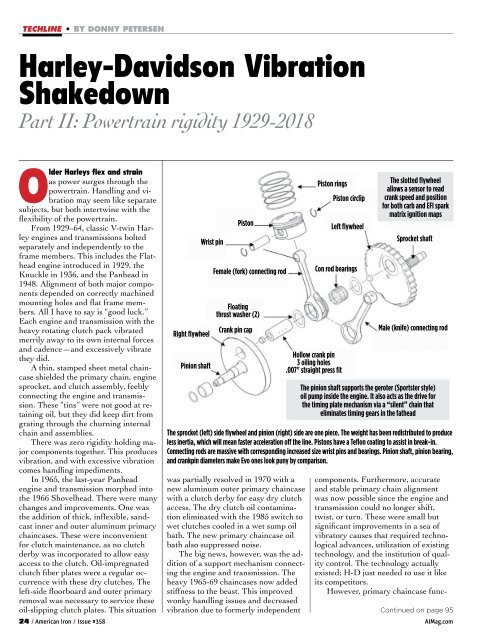American Iron Magazine December 2017
You also want an ePaper? Increase the reach of your titles
YUMPU automatically turns print PDFs into web optimized ePapers that Google loves.
TECHLINE • BY DONNY PETERSEN<br />
<br />
<br />
Part II: Powertrain rigidity 1929-2018<br />
<br />
as power surges through the<br />
powertrain. Handling and vibration<br />
may seem like separate<br />
subjects, but both intertwine with the<br />
<br />
From 1929–64, classic V-twin Harley<br />
engines and transmissions bolted<br />
separately and independently to the<br />
head<br />
engine introduced in 1929, the<br />
Knuckle in 1936, and the Panhead in<br />
nents<br />
depended on correctly machined<br />
bers.<br />
All I have to say is “good luck.”<br />
Each engine and transmission with the<br />
heavy rotating clutch pack vibrated<br />
<br />
<br />
they did.<br />
A thin, stamped sheet metal chaincase<br />
shielded the primary chain, engine<br />
<br />
connecting the engine and transmis-<br />
-<br />
<br />
grating through the churning internal<br />
chain and assemblies.<br />
-<br />
<br />
<br />
comes handling impediments.<br />
In 1965, the last-year Panhead<br />
engine and transmission morphed into<br />
<br />
changes and improvements. One was<br />
<br />
cast inner and outer aluminum primary<br />
<br />
<br />
derby was incorporated to allow easy<br />
access to the clutch. Oil-impregnated<br />
-<br />
<br />
<br />
removal was necessary to service these<br />
<br />
Right flywheel<br />
Pinion shaft<br />
Wrist pin<br />
The sprocket (left) side flywheel and pinion (right) side are one piece. The weight has been redistributed to produce<br />
less inertia, which will mean faster acceleration off the line. Pistons have a Teflon coating to assist in break-in.<br />
Connecting rods are massive with corresponding increased size wrist pins and bearings. Pinion shaft, pinion bearing,<br />
and crankpin diameters make Evo ones look puny by comparison.<br />
was partially resolved in 1970 with a<br />
new aluminum outer primary chaincase<br />
<br />
tion<br />
eliminated with the 1985 switch to<br />
wet clutches cooled in a wet sump oil<br />
<br />
bath also suppressed noise.<br />
-<br />
-<br />
<br />
heavy 1965-69 chaincases now added<br />
<br />
wonky handling issues and decreased<br />
<br />
Piston rings<br />
Piston circlip<br />
Left flywheel<br />
components. Furthermore, accurate<br />
and stable primary chain alignment<br />
was now possible since the engine and<br />
<br />
<br />
<br />
vibratory causes that required techno-<br />
<br />
-<br />
<br />
<br />
its competitors.<br />
-<br />
Continued on page 95<br />
24 / <strong>American</strong> <strong>Iron</strong> / Issue #358 AIMag.com<br />
Piston<br />
Female (fork) connecting rod<br />
Floating<br />
thrust washer (2)<br />
Crank pin cap<br />
Con rod bearings<br />
Hollow crank pin<br />
3 oiling holes<br />
.007" straight press fit<br />
The slotted flywheel<br />
allows a sensor to read<br />
crank speed and position<br />
for both carb and EFI spark<br />
matrix ignition maps<br />
Sprocket shaft<br />
Male (knife) connecting rod<br />
The pinion shaft supports the geroter (Sportster style)<br />
oil pump inside the engine. It also acts as the drive for<br />
the timing plate mechanism via a “silent” chain that<br />
eliminates timing gears in the fathead


